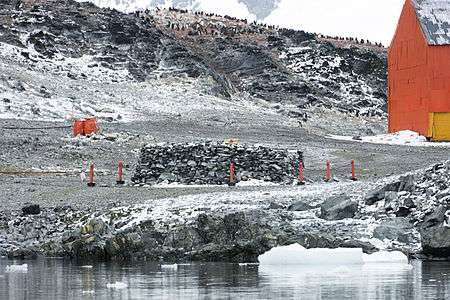Hope Bay

Hope Bay (Spanish: Bahía Esperanza) on Trinity Peninsula, is 5 kilometres (3.1 mi) long and 3 kilometres (1.9 mi) wide, indenting the tip of Antarctic Peninsula and opening on Antarctic Sound. It is the site of the Argentinian Antarctic settlement Esperanza Base, established in 1952
Important Bird Area
The bay has been identified as an Important Bird Area (IBA) by BirdLife International because it supports one of the largest Adélie penguin colonies in Antarctica with around 125,000 pairs. Other birds nesting at the site include gentoo penguins, brown skuas, Antarctic terns, Wilson's storm-petrels, kelp gulls and snowy sheathbills.[1]
History

The Bay was discovered on January 15, 1902 by the Swedish Antarctic Expedition under Otto Nordenskiöld, who named it in commemoration of the winter spent there by J. Gunnar Andersson, S.A. Duse, Toralf Grunden and José María Sobral of his expedition after his ship (the Antarctic) was crushed by the ice and lost. They were eventually rescued by Argentine corvette Uruguay.
The old British Base "D" was established here in 1945. It partially burned in 1948, with the loss of two lives,[2] and was closed in 1964. On December 8, 1997 the British Antarctic Survey transferred the base to Uruguay, who renamed it Teniente Ruperto Elichiribehety Uruguayan Antarctic Scientific Station (ECARE).
The present Argentine Esperanza Base was established in 1952. It is operated by the Instituto Antartico Argentino and has an average of 55 inhabitants in winter. The base installations have displaced part of a penguin rookery. The first known birth of any human being in Antarctica occurred here in 1978, when Emilio Palma was born to the wife of an Argentine naval officer.
Hope Bay/Esperanza was also the scene of the first ever shots fired in anger in Antarctica in 1952 when an Argentine shore party fired a machine gun over the heads of a British Antarctic Survey team unloading supplies from the John Biscoe. The Argentines later extended a diplomatic apology, saying that there had been a misunderstanding and that the Argentine military commander on the ground had exceeded his authority.
Historic site
 |
|
The ruins of a stone hut built in January 1903 by members of the Swedish expedition can still be seen; it has been designated a Historic Site or Monument (HSM 39), following a proposal by Argentina and the United Kingdom to the Antarctic Treaty Consultative Meeting.[3]
References
- ↑ "Heywood Island". BirdLife data zone: Important Bird Areas. BirdLife International. 2013. Retrieved 2013-01-07.
- ↑ Deaths of FIDS and BAS Staff in Antarctica
- ↑ "List of Historic Sites and Monuments approved by the ATCM (2012)" (PDF). Antarctic Treaty Secretariat. 2012. Retrieved 2013-12-31.
- Antarctica. Sydney: Reader's Digest, 1985, p. 156-157.
- Child, Jack. Antarctica and South American Geopolitics: Frozen Lebensraum. New York: Praeger Publishers, 1988, p. 73.
- Lonely Planet, Antarctica: a Lonely Planet Travel Survival Kit, Oakland, CA: Lonely Planet Publications, 1996, 302-304.
- Stewart, Andrew, Antarctica: An Encyclopedia. London: McFarland and Co., 1990 (2 volumes), p. 469.
- U.S. National Science Foundation, Geographic Names of the Antarctic, Fred G. Alberts, ed. Washington: NSF, 1980.
External links
| ||||||||||||||
Coordinates: 63°23′S 56°59′W / 63.383°S 56.983°W
